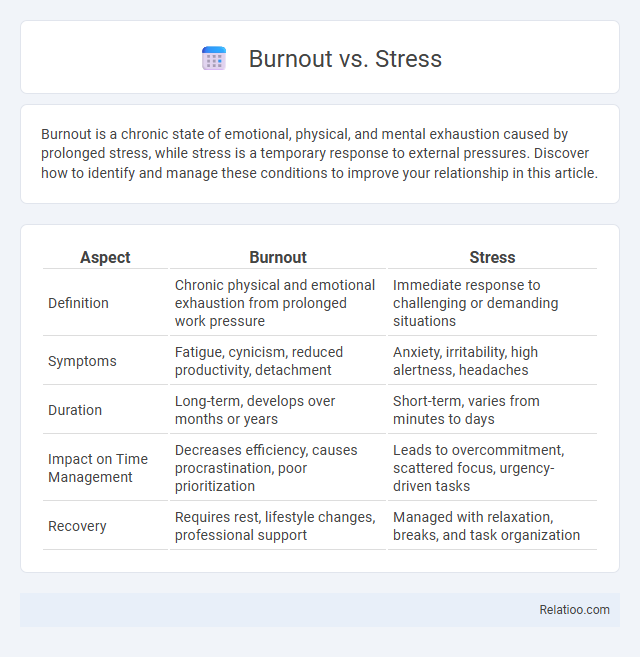Burnout is a chronic state of emotional, physical, and mental exhaustion caused by prolonged stress, while stress is a temporary response to external pressures. Discover how to identify and manage these conditions to improve your relationship in this article.
Table of Comparison
| Aspect | Burnout | Stress |
|---|---|---|
| Definition | Chronic physical and emotional exhaustion from prolonged work pressure | Immediate response to challenging or demanding situations |
| Symptoms | Fatigue, cynicism, reduced productivity, detachment | Anxiety, irritability, high alertness, headaches |
| Duration | Long-term, develops over months or years | Short-term, varies from minutes to days |
| Impact on Time Management | Decreases efficiency, causes procrastination, poor prioritization | Leads to overcommitment, scattered focus, urgency-driven tasks |
| Recovery | Requires rest, lifestyle changes, professional support | Managed with relaxation, breaks, and task organization |
Understanding Burnout and Stress: Key Differences
Burnout is a state of chronic physical and emotional exhaustion caused by prolonged stress, characterized by feelings of detachment, reduced performance, and a sense of helplessness. Stress, meanwhile, is a response to immediate pressures or challenges, often resulting in temporary anxiety or tension that can be motivating in short bursts. Understanding the key differences between burnout and stress is essential for effective mental health management and early intervention, as burnout requires long-term recovery strategies, whereas stress can often be managed through short-term coping mechanisms.
Defining Burnout: Causes and Symptoms
Burnout is a state of chronic physical and emotional exhaustion caused by prolonged stress, often linked to excessive workloads, lack of control, and insufficient support at work or in personal life. Key symptoms include persistent fatigue, cynicism or detachment from responsibilities, and reduced performance or productivity. Unlike general stress, burnout leads to deeper mental health issues such as depression, anxiety, and a significant decrease in motivation and self-efficacy.
What Is Stress? Types and Triggers
Stress is the body's natural response to external pressures or demands, activating the fight-or-flight mechanism. Common types of stress include acute stress, which is short-term and situational, and chronic stress, which persists over extended periods, often due to ongoing challenges like work overload or financial concerns. Key triggers encompass environmental factors, emotional strain, and physical challenges, all influencing mental and physical health outcomes.
Physical Signs: Burnout vs. Stress
Physical signs of burnout often include chronic fatigue, persistent muscle tension, and frequent headaches, while stress typically manifests as increased heart rate, sweating, and digestive issues. You may notice that burnout leads to longer-lasting physical symptoms that impair daily functioning, whereas stress symptoms tend to fluctuate with external pressures. Identifying these differences is crucial for managing your well-being effectively and seeking appropriate interventions.
Emotional Impact: Comparing Burnout and Stress
Burnout and stress both significantly affect emotional well-being, but burnout leads to deeper emotional exhaustion, detachment, and feelings of inefficacy. Stress typically triggers short-term emotional responses like anxiety and irritability, while burnout results in prolonged emotional depletion and a sense of helplessness. Understanding these differences is crucial for developing targeted mental health interventions and workplace support systems.
Workplace Factors: Contributing to Burnout and Stress
Workplace factors such as excessive workloads, lack of control over tasks, and insufficient support from management significantly contribute to both burnout and stress. High job demands paired with low resources create chronic stress that, if unaddressed, leads to burnout characterized by emotional exhaustion, depersonalization, and reduced personal accomplishment. Organizational practices that neglect employee well-being exacerbate these conditions, making targeted interventions essential for maintaining mental health and productivity.
How Burnout Develops from Prolonged Stress
Burnout develops from prolonged stress when continuous exposure to high demands exceeds an individual's coping capacity, leading to physical and emotional exhaustion. Chronic stress triggers hormonal imbalances and disrupts cognitive functions, impairing productivity and overall well-being. Over time, this persistent strain depletes energy reserves, causes detachment, and diminishes motivation, hallmark symptoms of burnout.
Prevention Strategies for Burnout and Stress
Effective prevention strategies for burnout and stress include establishing clear boundaries between work and personal life, implementing regular physical activity, and practicing mindfulness techniques to manage emotional exhaustion. Employers can reduce burnout by promoting a supportive work environment, providing access to mental health resources, and ensuring manageable workloads to prevent chronic stress. Early recognition of symptoms and consistent self-care routines are essential to maintain mental well-being and avoid the progression from stress to full burnout.
Effective Coping Mechanisms
Effective coping mechanisms for burnout include setting clear boundaries, practicing regular self-care, and seeking professional support such as counseling or therapy. Stress management benefits from techniques like mindfulness meditation, physical exercise, and time management strategies to reduce triggers and maintain balance. Combining these approaches helps differentiate and address both burnout and stress, promoting long-term mental wellness.
Seeking Help: When to Act on Burnout or Stress
Recognizing when stress escalates into burnout is crucial for maintaining your mental health and productivity. Seek professional help if symptoms like chronic exhaustion, detachment, or reduced performance persist despite rest and self-care. Early intervention can prevent long-term psychological effects and improve coping strategies for both stress and burnout.

Infographic: Burnout vs Stress
 relatioo.com
relatioo.com